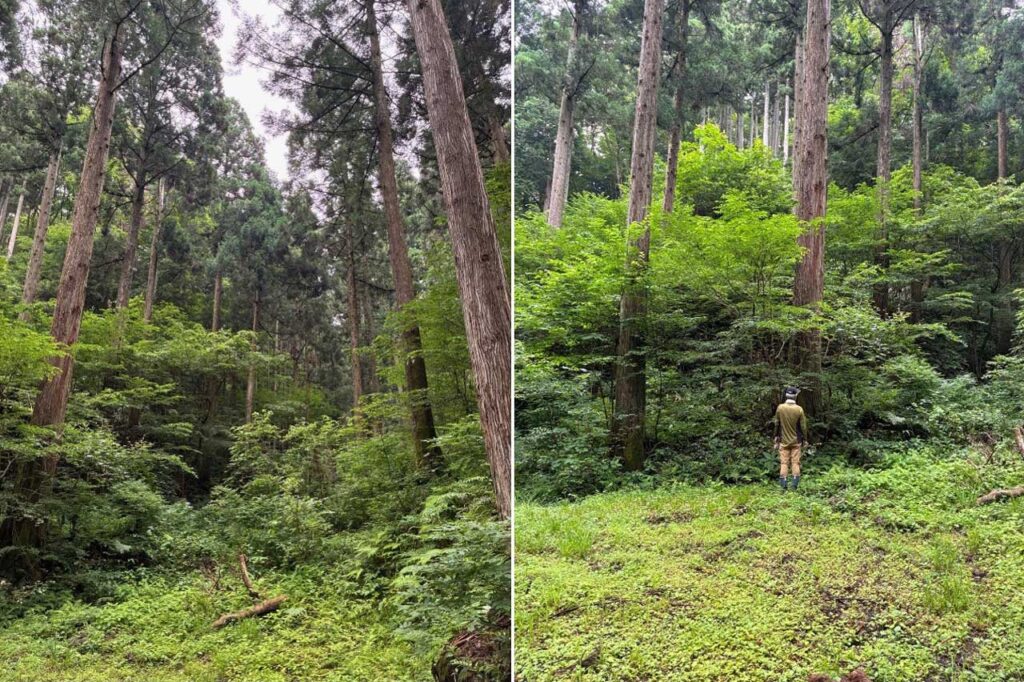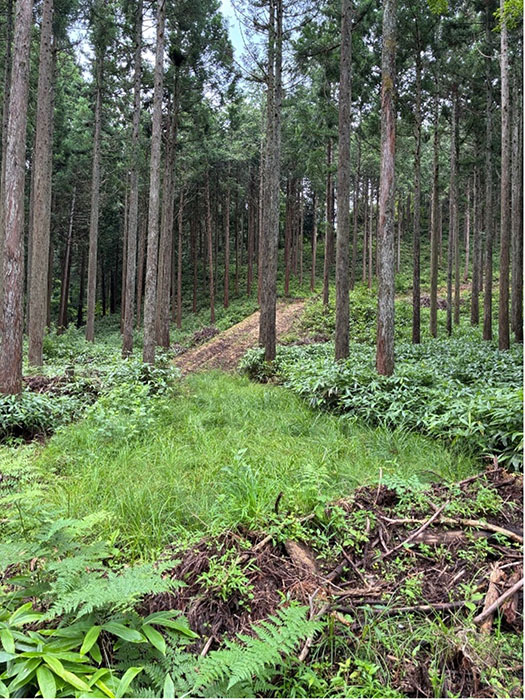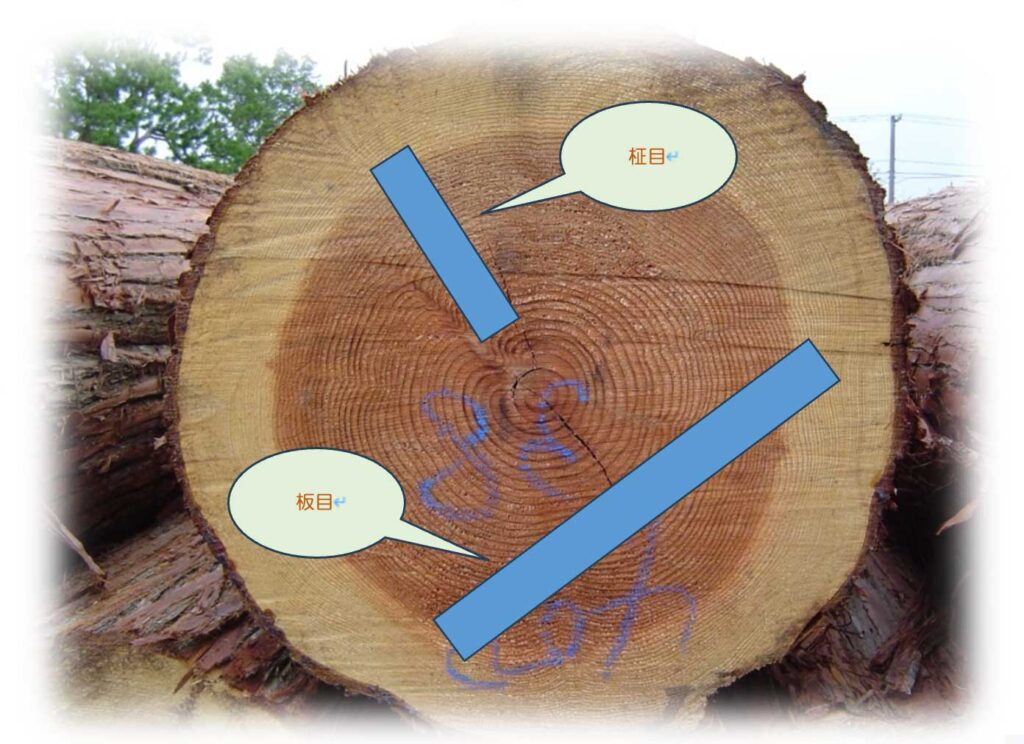What kind of communication is necessary to eliminate "deteriorating forests" that have become less valuable due to long cutting periods?
Updated by Yasunao Kobayashi on July 30, 2025, 6:07 PM JST
Yasuhisa KOBAYASHI
Alpha Forum, Inc.
President of Alpha Forum, Inc. and Steering Committee Member of the Platinum Forest Industry Initiative. Ltd. in 2001, taking advantage of the company's venture support program. In September 2023, he received the Wood Use System Research Association Award.
In late June, we conducted a forest survey. The participants were: the local forestry cooperative's counselor, a person who wanted to sell the forest (the owner), a person who wanted to buy the forest, and myself. The forest owners were more interested in utilizing the forest for the benefit of the community than in selling it at a high price. The total area of the forest is over 20 ha, mainly cedar with 10-20% cypress.
What kind of feeling does the reader of this column get from the photo below, which I took during my field trip?

The tree has been cleared and thinned and is growing well...but it is a bit of a shame, a waste of a mountain forest. In the photo on the right, a 172-cm-tall man is standing in front of a cedar tree. This means that the diameter at breast height of this tree is over 70 cm. The wood products we often see have a pattern of annual rings. Broadly speaking, there are "itame" (*1) and "masaome" (*2). The thicker the wood is, the more likely it is to be "quarter-sawn," and it may be traded at a reasonably high price. Visible wood used for nagashige (a long tapestry in a Japanese room), kamoi (a door frame for a Japanese-style room) and yakumono (a pillar), is preferred as it does not have any "fushimono" (imperfections).
It is thick enough, but now I would like you to pay attention to the tree's skin. Can you see the marks where the branches have fallen out? The tree shown in the photo is a "namizai," which means that it has no branches. It is what is called "Namizai. It is also unfortunate that the height of the tree is low for a tree with a large diameter at breast height. This may be a characteristic of the status of this area (*forest growth conditions), but it is a "tree with no growth. The first to second ball of the tree is thick, but from the third ball of the tree, the tree becomes much thinner. This means that the difference between the first and the second end of the log (diameter of the end of the log) is large. When sawing long columns, the volume of the backboard increases because it is adjusted to the end diameter, which means that the ratio of the wasted portion (the portion that cannot be sold at a high price) becomes larger. This is also regrettable!
There are also problems in producing material with a breast height diameter of over 70 cm. Coniferous trees can be efficiently worked by using a harvester of high-performance forestry equipment for lumber production (felling - branch clearing), but if the trees are this thick, even 0.45 (comma yongo: bucket size of a backhoe is 0.45 cubic meters) class heavy equipment is dangerous, so chainsaw felling and pulling out with a winch, etc. are used, There is a possibility of branch clearing with a chainsaw. It is possible to put in 0.7 class heavy equipment to do the work, but the forestry road - work road would have to be widened. It could be special logging.
In short, it is "costly to cut down and haul out" because it cannot be handled by a rational system of operations. Even if the material is hauled out with difficulty, the sawmill machine will not accept it. While band saws with carts (single band saws) have no problem with logs of this diameter, the more efficient twin band saws are generally designed for logs up to 40-60 cm in diameter. They are also costly after they are felled and hauled out.
In the log market, the unit volume price of logs with a terminal diameter of 50 cm or more tends to fall. Even if they are put out with great effort, they are likely to become "troublesome. So, why do we find ourselves in this situation?
Thinning is cutting down "unwanted trees". That is why it is subsidized. Thinning to increase the value of the remaining trees has somehow become "harvesting logs that can be sold at a high price. Of course, thinned timber should be traded with monetary value if it can be used, but aren't the most profitable trees being harvested today? The company is harvesting the most profitable trees. It is also called harvest thinning, but at least the intention to increase the value of the remaining trees should not be abandoned. Logs with a diameter of around 24 cm (medium grain: nakame) are very popular ≒ traded at a high unit price per volume. High-performance forestry machinery systems match this level of material production.
Although there are not zero forest owners who believe that lumber prices will eventually rise, as they did in the past when Japanese-style rooms were in great demand, it is necessary to thin the forests in anticipation of final demand. Thinning should essentially begin with the thickest trees. The "harvesting of trees that can be sold at a high price" should be changed, partly due to the impact of the revenue targets in the forest management plan, and a return to the essence of forest care, which produces many functions. If trees that can no longer be felled are left as they are, they will eventually fall naturally. Typhoons and gusts of wind will topple them, and new trees will sprout again. Humans are allowed to live in the bounty of the forests, so we should think more about the forests, get closer to them, and take care of them.

The photo above shows a forest of cedar trees that had just been harvested for medium-sized logs. The thinning had just been completed. Why not harvest everything (main logging)? As I mentioned earlier, making the trees any thicker would reduce their value and make it more difficult to cut them down and remove them from the forest. We did not know how many years they planned to cut the main trees, but the three members of our survey team were unanimous in saying, "They have postponed the cost with a long logging season..." We were not sure how long they planned to cut the main trees, but we were sure that they were planning to do so.
It takes decades of land preparation - planting - clearing underbrush - thinning - pruning - thinning... before the material is ready for harvest. These costs are an attempt to increase the value of the main harvest. In some cases, the thinning in the middle of the process yields something that can be sold, so the amount sold minus the logging costs may be returned to the forest owner. Now, here, it is acceptable to consider the care of the trees until the one-cycle final harvest as a "cost".
Since the remaining amount of gross operating income after subtracting the costs incurred so far from the amount of material sold when the main logging is done becomes gross operating income, there is a strong possibility that the company will be "in the red" if the currently unappreciated costs of pruning and thinning are recorded on the balance sheet (balance sheet: BS). Then, even if the trees are already thick enough to sell in the market, the company will consider reestablishing a "long thinning policy" to postpone the settlement of costs. The reason for this is that they want to make the price as high as possible if they can sell the timber in the process. Since the postponement is 20 to 30 years in the future and the market at that time is not known, it is possible to postpone it for the time being. Costs spent on water source recharge, disaster prevention, and biodiversity may also be capitalized in the BS, but since these cannot be harvested, it is better not to record them as an increase in assets. Forest conservation, forest growth and nursery are public works. I think that the accounting should be settled on a yearly basis, and that impairment accounting should be thoroughly applied to these assets. The operation should be similar to corporate accounting.
In many cases, the adjustment of transfer prices between mountain owners and potential purchasers of forests has become difficult due to long-standing discrepancies in value assessment. Against this backdrop, many forests are left unattended. Just because you own a forest does not mean it is OK to leave it alone. The forest industry is largely a public enterprise. If you own forests, or if you have forests that you have inherited from generations past, at the very least, you should clearly understand the boundaries of the forests you own and manage them accordingly.
This lackadaisical communication about mountain forests has resulted in "unfortunate mountain forests (forests). 80-90% of Japan's forests are more than 10 years old (50 years after planting). They have reached the so-called "harvesting stage. It is time to seriously consider using these forests for the benefit of the local community. (Yasunao Kobayashi, President, Alpha Forum, Inc. and Steering Committee Member, Platinum Forest Industry Initiative)

<解説>
*1: What is itame?
Lumber cut from the top portion to the bottom portion of the log. Although the size of the wood will vary between the end and center portions, most of the log can be used as lumber.
2: What is "Masame"?
Sawn lumber is "quarter sawn" lumber that is sawn from the center of the log to the outside in a radial pattern from the center. The "radius" of a quarter-sawn log is the maximum size of the log, and the half-section of the log that cannot be sawn is the "quarter-sawn" section.